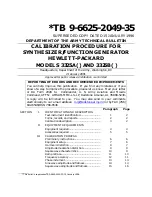
81
GL
OBAL
0
1
2
3
4
5
6
GLOBAL 1: MIDI
1–1: MIDI
Here you can make MIDI-related settings that affect this
instrument.
1–1a: MIDI Setup
MIDI Channel
[01…16]
Sets the global MIDI channel.
The global MIDI channel is used in the following cases.
• When transmitting and receiving performance data in
Program mode (PROG 0: Play).
• When selecting combinations via MIDI in Combination
mode (COMBI 0: Play).
• When controlling timbres or effects that have been set
to Gch in various modes
• When transmitting and receiving system exclusive
messages
About MIDI reception
In Program mode (PROG 0: Play), MIDI data is received on
the global MIDI channel, but in Combination mode (COMBI
0: Play) or Multi mode, MIDI data is received on the MIDI
channel specified for each timbre or track.
In Combination mode (COMBI 0: Play) and Multi mode
(MULTI 0: Play), program changes received on the global
MIDI channel will switch the combination or multi set.
Use the global MIDI channel to switch IFX , MFX1 and
MFX2 on/off.
To control the pan following IFX, sends 1/2, MFX 1/2 and
MEQ, use the global MIDI channel in Program mode; in
Combination, or Multi mode, use the channel specified sep-
arately by “Control Channel” for IFX, MFX1, MFX2, and
MEQ. By setting “Control Channel” to Gch, you can control
these parameters from the global MIDI channel.
MIDI transmission when this instrument’s
controllers are operated
In Program mode, this data will be transmitted on the global
MIDI channel. In Combination mode, data will be transmit-
ted simultaneously on the global MIDI channel and on the
MIDI channels of timbres whose “Status” (COMBI 2–1) is set
to EXT or EX2.
In Multi mode, musical data will be transmitted on the chan-
nel of the track (“Status” BTH, EXT, or EX2) specified by
“Control Track” (MULTI 0–1).
Note Receive
[All, Even, Odd]
This setting specifies which of the note messages played on
this instrument’s keyboard or received via MIDI will be
sounded. If you connect another X50/microX unit to this
instrument in order to increase the total polyphony, set one
unit to Even and the other to Odd, and set both units to
sound.
All:
All note numbers will be received. Normally you will
leave this set to All.
Even:
Even-numbered notes (C, D, E, F#, G#, A#) will sound.
Odd:
Odd-numbered notes (C#, D#, F, G, A, B) will sound.
This setting has no effect on the MIDI data that is
received.
MIDI Clock
[Internal, Ext-MIDI, Ext-USB, Auto]
Set this parameter when you wish to synchronize an exter-
nal MIDI device (sequencer or rhythm machine etc.) with
the X50/microX’s internal arpeggiator.
Internal:
The internal arpeggiator will synchronize to the
X50/microX’s own internal clock.
Select the Internal setting when using the X50/microX by
itself, or when you want the X50/microX to be the master
(controlling device) so that another connected external MIDI
device will synchronize to the MIDI Clock messages trans-
mitted from the X50/microX.
Ext-MIDI:
The arpeggiator of the X50/microX will synchro-
nize to MIDI Clock messages transmitted from an external
MIDI device connected to the MIDI IN connector.
Ext-USB:
The X50/microX will synchronize to the MIDI
Clock messages transmitted by an external MIDI device con-
nected to the USB connector, and the internal arpeggiator of
the X50/microX will operate as a slave device.
Use the Ext-MIDI or Ext-USB setting when you are using
this instrument as a slave (controlled device) that synchro-
nizes to the MIDI Clock messages received from an external
MIDI device. This instrument will respond to MIDI real-
time messages (Start, Stop, Continue, Song Select, Song
Position Pointer) from an external sequencer.
Auto:
Normally, operation will be the same as Internal. If
you choose this setting, and the X50/microX receives MIDI
clock messages from an external device, it will automatically
switch to the same operation as the Ext-MIDI or Ext-USB
settings.
If you have chosen the Auto setting when using an
external sequencer, the X50/microX will automatically
switch to the same operation as Internal if the external
sequencer is not transmitting MIDI clock.
If no new MIDI clock messages are received from the
MIDI IN or USB connector for an interval of 500 ms
after receiving MIDI clock, start, or continue messages,
or if the X50/microX’s arpeggiator has been started
without receiving MIDI clock, start, or continue mes-
sages from the MIDI IN or USB connector, it will switch
to the same operation as the Internal setting.
Audition playback will occur at the pre-specified
tempo, regardless of the “MIDI Clock” setting.
1–1a
1–1b
ODD
EVEN
Another X50/microX
MIDI OUT
USB
MIDI IN
USB













































